Claussen Pickles are kosher dill pickles at their crunchiest, saltiest best! These homemade Claussen pickles taste like the commercial ones you find at the store, but better. And better yet, they’re ridiculously easy to make!
Whether you’re new to pickle making or a pickle veteran, you NEED to make these half sour pickles! And wonder of wonders, you don’t need to know how to can to make these super fresh, crunchy pickles! Claussen dill pickles are meant to be eaten fresh.
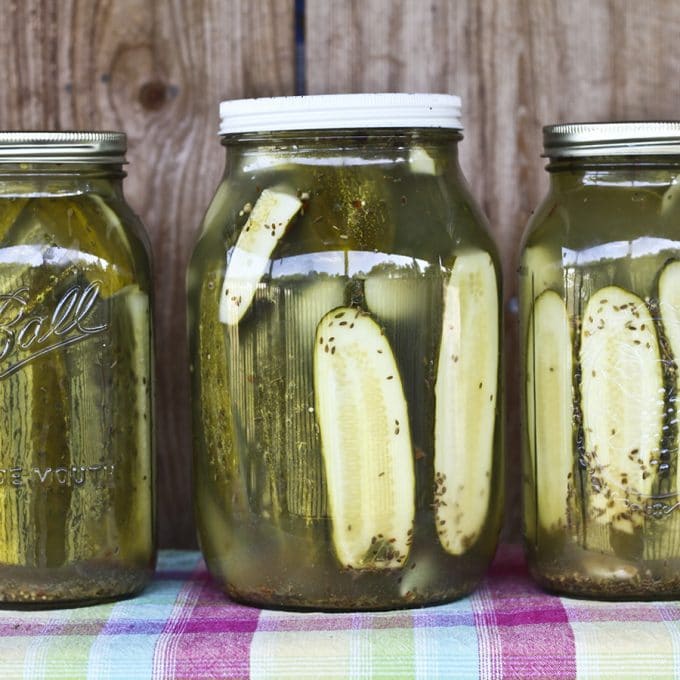
Homemade Claussen Knock-Off Pickles: Always crunchy and garlicky, this perfect homemade pickle recipe requires no special equipment, & no canning experience.
It’s common knowledge that I have a salty tooth rather than a sweet tooth. When the weather does what it has been doing lately (making us all do our best Shadrach, Meshach and Abednego impersonations) I can’t think of a single thing I find more refreshing than an icy-cold, salty, crunchy pickle.
It’s not just me, it’s my whole family: mother, sisters, brothers, cousins, aunts, grandparents, kids, husband… I married a man who loves pickles so much he eats the pickles and then drinks the juice from the jar.
I grew up eating my Grandma’s homemade dill pickles like the supply was endless and moved on to canning my own pickles as soon as I had a kitchen of my own. There’s just something about a homemade dill pickle that makes me happier than any pickled cucumber ever should.
My little sister, Jessamine, and I compare our homemade pickles from year to year the way some people compare wine vintages.
Dill Pickle Recipe
But there is one pickle that stands head-and-shoulders (were pickles to *have* heads and shoulders) above all others. I’m talking about the pickles you see here. That’s right: Homemade Claussen Dill Pickles.
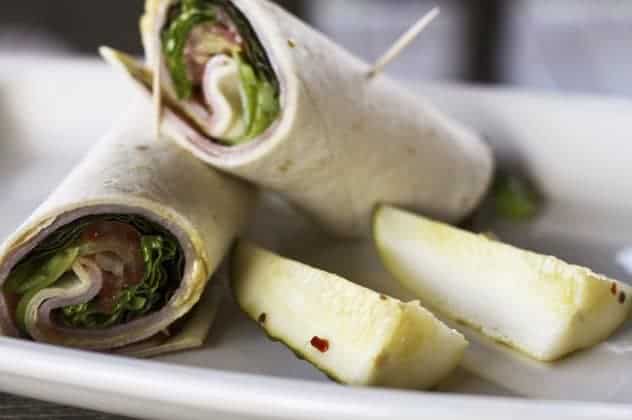
Recipe for Claussen Pickles
What do you need in order to make this recipe for Claussen Half Sour Pickles at home? Let’s get a quick list for both ingredients and equipment out of the way, shall we?
Equipment for Making Claussen Pickles at Home
- A Glass gallon jar or 4 glass quart jars or other food safe container with a tight fitting lid
- Measuring cup
- Chef’s knife or paring knife
Ingredients for Making Homemade Claussen Pickles Copycat
- Small to medium size pickling cucumbers (check your local farm stand or farmer’s market!)
- Apple Cider Vinegar (don’t fret- it doesn’t taste like apple cider and isn’t even a little sweet!) or white vinegar
- Kosher Salt
- Garlic
- Dill (either fresh or dill seed)
- Pickling spices (available here)
A quite note on your vinegar choice: I opt for apple cider vinegar because it’s a smoother vinegar than white vinegar. It does not impart any sweetness or apple taste to the pickles whatsoever.
If you can’t find it (pssst. It’s right next to white vinegar in even moderately stocked grocery stores) or don’t feel like buying it, you can most certainly substitute white vinegar. It’ll just taste a little sharper. (And technically store bought Claussen pickles have white vinegar, so you do you!)
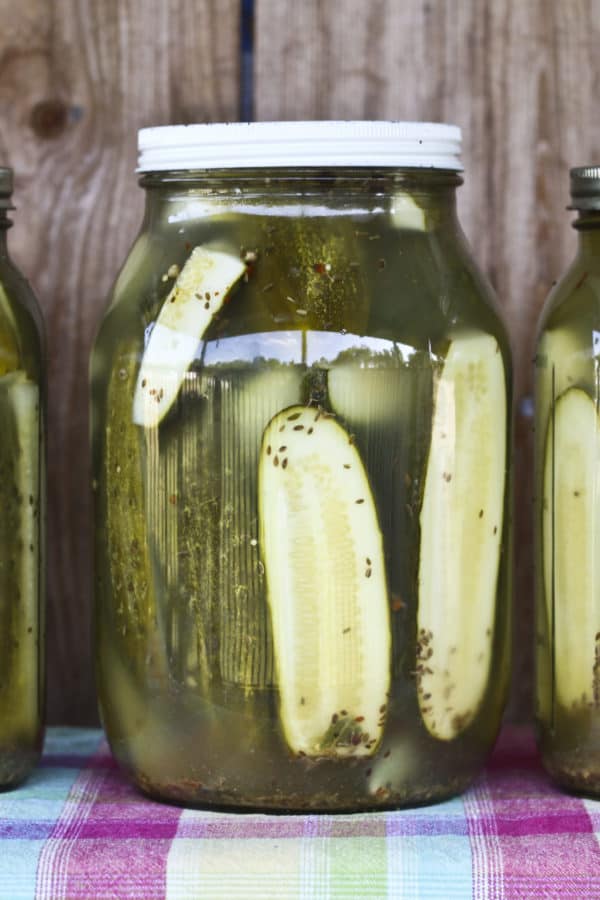
And ya’ll. These homemade half sour pickles are so easy to make it’s almost criminal.
The hardest part is the 2 to 4 day wait for them to be done. Truth be told, though, I’ve snacked on them the day after I made them and been a very happy camper.
Claussen Pickle Recipe
These are homemade refrigerated deli pickles, also known as Lithuanian half-sours, also known (in the commercial equivalent) as Claussen dill kosher pickles, also known as the best pickles ever known to mankind.
Here’s the thing. While I do love my other homemade pickles dearly (otherwise why would I continue canning ninety-something quarts year after year after year), these are by far my all-time favourites.
CRUNCH. That’s what you hear when you bite these. There is no flop, no squish, no soft pickles. These things almost bite back.
This also happens to be the perfect dill pickle recipe for beginning pickle makers. If you’re not into canning, these refrigerator pickles are a godsend. Even if you ARE canning obsessed, like yours truly, this Claussen pickle recipe should be in your pickle repertoire too.
Please note that this Claussen pickle recipe is not suitable for canning. The brine is fermented and not very acidic, which means it has far too high a PH to can safely. If you’re looking for a great canned dill pickle recipe, try this home canned garlic dill pickle recipe.
Refrigerator Pickles
Here’s where we get into the best part of this pickle recipe (aside from the crunch and flavor). You don’t have to cook anything to make these pickles; not one single thing. The brine is stirred together, the cucumbers are rinsed, trimmed and stuffed into a jar with garlic cloves and spices.
These half sour pickles are NOT CANNED. They are simply put into jars. Amen!
When it’s summer time and the idea of turning on the stove makes me want to crawl into an (air conditioned) hole, these pickles are a welcome treat. Not only is that cold crunchy refrigerator pickle waiting to cool me off at the end of the prep time, but I don’t have to heat up my kitchen by even one single degree to get there.
Remember that pickling isn’t just for cucumbers, either! Try out our Pickled Brussels Sprouts, Quick Pickled Red Onions, and famous Candied Jalapenos!
How to Make Pickles FAQ
Please, please, please give these a go even if you have never made a pickle before. There is nothing scary or intimidating here. Wash, slice, stuff, stir, pour, sit, wait.
- Trim 1/8-inch from the blossom end of each cucumber and slice them in half lengthwise or into quarters. The size you choose depends on how large your cucumbers are and how big you want the pickles to be when they’re done. This helps minimize the chances of soft pickles.
- In a gallon jar (or large, wide-mouth, food-safe container) layer the dill heads or seed, pickling spice or mustard seed, and garlic cloves and sliced cucumbers. If you’re dividing the cucumbers up between smaller containers, just divide the garlic and spices evenly between the containers, too.
- Stir your brine together in a separate container. You WILL have more brine than you have space for in the jars, but that’s why you pack the spices in the jars. Just store extra brine in a jar in the refrigerator and use it to top off your pickles if the brine starts evaporating.
- Pour the brine over the cucumbers, taking care to make sure all of them are fully submerged. If needed, place a plate or mug or other ziploc bagged can of beans on the cucumbers to weigh them down and keep them under the brine!
- Cover the jars lightly not tightly and leave out of direct sunlight on the counter for two to four days or until the pickles are picklicious.
- If your kitchen is pretty hot or humid, you can stash them directly in the refrigerator. They’ll just take a couple of days longer to get fabulous. Your patience will be rewarded.
On the plus side, the wait is only two to four days which is significantly less than the six week wait of the canned pickles. Besides, as I said, there is the crunch factor
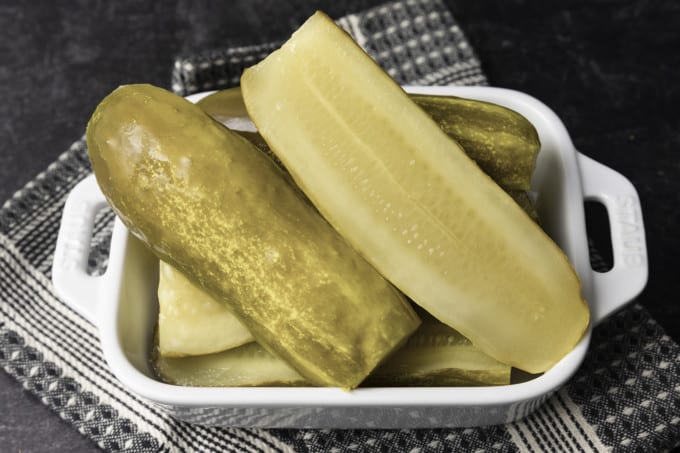
Troubleshooting Your Homemade Claussen Pickles
These pickles are easy peasy to make, but there still may be a couple of things that pop up from time to time that make you go “Hmmm…” In no particular order, here are some of the most commonly asked questions about them and some answers!
- Why is my pickle brine cloudy? Okay, I lied. This is the most common question and that’s because the brine becomes cloudy naturally as a consequence of fermentation (which is what’s happening here.) No worries.
It’s all natural. This half sour pickle recipe (more on this to come) is a fermented pickle recipe and that just happens.
Another possible cause of intense cloudiness or discolouration in your brine is using table salt. The iodine in table salt can also give off flavours to your pickles, so it’s best to stick with kosher salt or pickling salt for these bad boys! - Is the scum, foam, or film on top of my pickle brine dangerous? It’s that pesky (and delicious) fermentation again! This is another thing you don’t have to worry about.
Just scrape it off with a spoon, discard, and top off with a little of that extra brine you whipped up. (See the recipe card for details.) But do remove the scum or it could cause your pickles to go bad. - My pickles went soft! How do I prevent this? This particular tragedy could have two causes.
First, you may have failed to remove enough of the blossom end of the cucumber. There is a naturally occurring enzyme in the blossom end of cucumbers that causes pickles to break down and become soft if it is not removed. Next time, just slice more off.
Second, you may have started with less than spectacularly fresh cucumbers. An older cucumber has had longer for the aforementioned enzyme to kick in, and it has already started its work.
The best solution for this issue is to use cucumbers that have either been picked fresh that day or have been refrigerated steadily since very shortly after being picked a couple of days previously. - Why did my pickles go bad? See that second reason in the “why did my pickles go soft” bullet point? That’s one culprit.
Other potential causes of spoiled pickles are using unwashed cucumbers or fresh dill, old or decayed garlic, bad spices, lower-than-5%-acidity-vinegar, failing to remove the scum from the brine or to keep the pickles submerged in the brine, or storing your pickles in warmer conditions. When in doubt, stash them in the refrigerator! - Why is there mold on my pickles? First, you have my condolences. Second, it’s because your pickles didn’t stay submerged in the brine. That brine has enough salt and acid to prevent mold growth if the cucumbers stay under the surface.
If you’re having trouble finding something that fits in the jar to keep this from happening, try popping a can or two of tomato paste or canned beans in a zipper top bag and gently inserting that into the jar. It should weigh it down enough to do the job. - Should I worry about the white sediment in my jar? This is another one in the “don’t sweat it” category. There are two potential reasons and both are completely harmless.
It’s either a natural consequence of the fermentation or anti-caking agents in the salt. Neither harms the pickles or effects the flavour, so don’t worry! - Why is my garlic blue/green/purple? As long you inspect the garlic before it goes into your jars and it is fresh as a daisy, you have nothing to worry about. It could be the type of salt you used or it could be the variety of garlic. Some types of garlic have a natural propensity to change pretty colours in vinegar.
It also may mean that your pickles were exposed to light. When garlic is exposed to light, it starts producing chlorophyll which is green. It also may indicate that your garlic is more mature.
In that case it is caused by sulfur compounds that naturally occur in more mature garlic reacting with minute traces of copper in the vinegar., but as long as there are no other signs of spoilage (soft or squishy texture, funky smell, discoloured spots), you’re good to go.
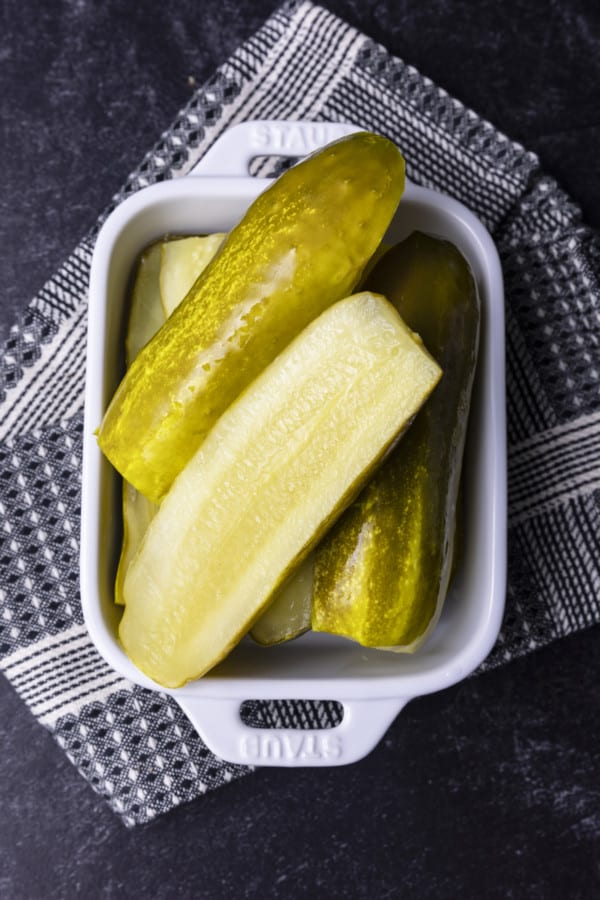
IMPORTANT NOTE: Because there is so much diversity in temperature, humidity, age of cucumbers, etc… involved in this recipe, please check your half sour pickles starting at 24 hours for doneness. If the pickles smell/taste pickley, move them to the refrigerator. Do not keep them on the counter longer than 4 days.
ANOTHER IMPORTANT NOTE: These pickles are not suitable for canning. They’re simply not acidic enough to can safely, and that is in addition to the fact that you’d ruin that perfectly crisp texture by introducing heat to the party.
What can I serve with these Homemade Claussen Knock-Off Pickles?
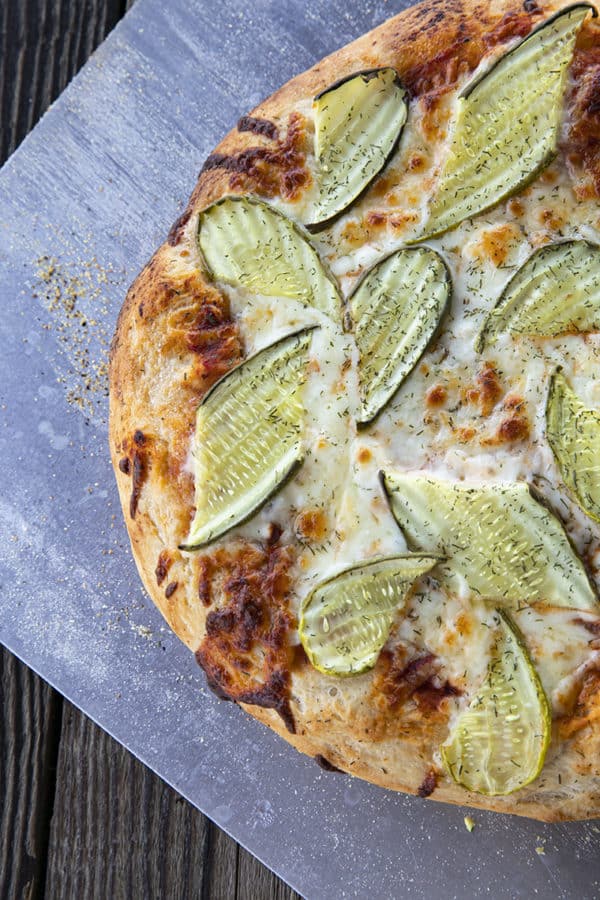
Start out by trying your half sour pickles in this Pickle de Gallo, Dill Pickle Dip, Dill Pickle Egg Salad, or Bagel Burgers with Dill Pickle Cream Cheese.
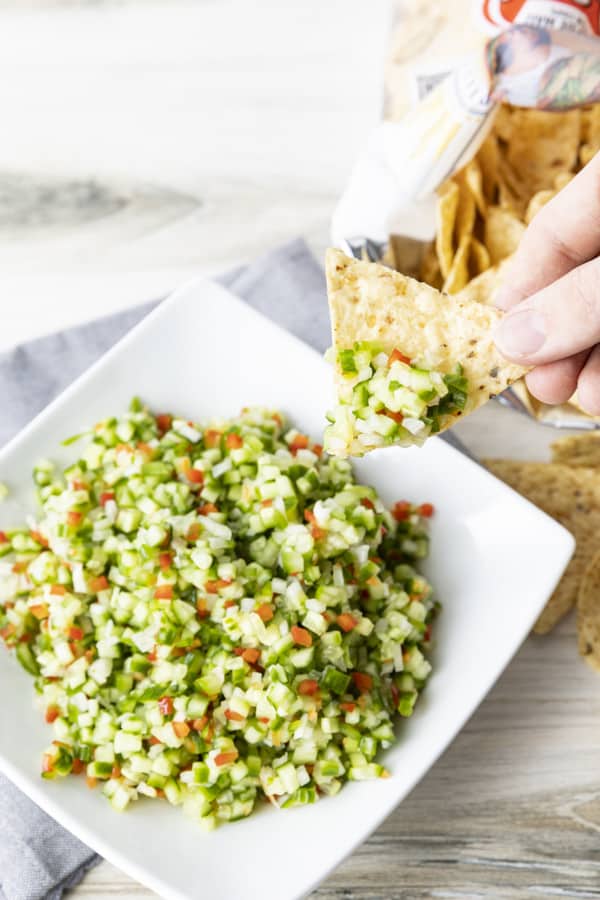
Even better, serve them on our Cheeseburger Salad or Pickle Pizza.
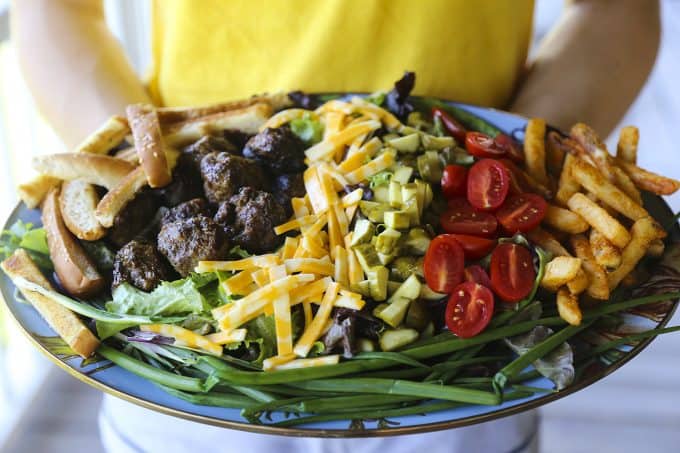
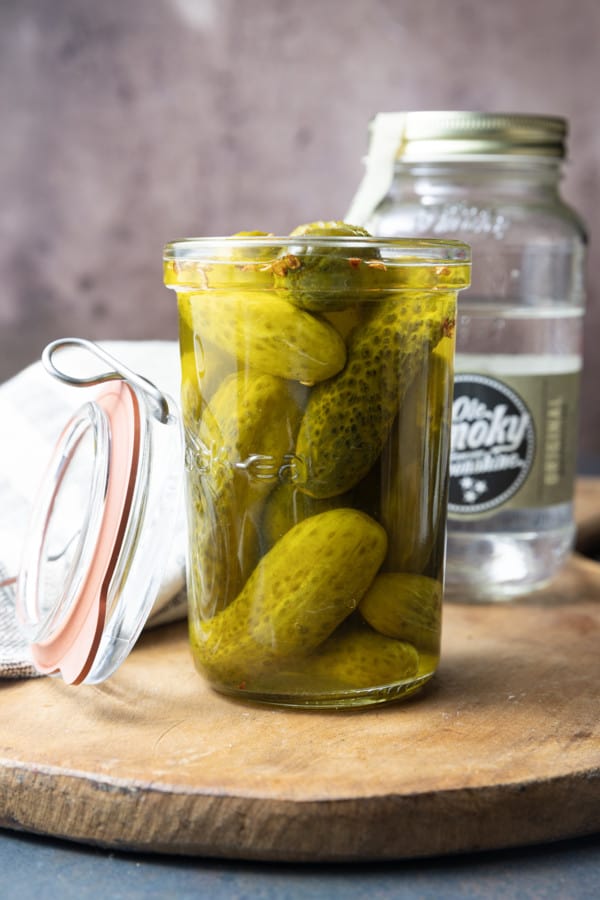
You can even take extra pickles (like that’s a thing!) and make these divine Moonshine Pickles. You’ve never had a better Bloody Mary than one made with homemade Moonshine Pickles!
Half Sour Pickle Recipe
What makes Claussen PIckles different from canned pickles? Claussen pickles, whether homemade or store bought, are a half sour pickle recipe.
That means they’re fermented instead of heat processed. That’s what gives them such great texture.
This half sour pickle recipe yields pickles that are crunchy to the point of making noise when you bite them, cold, and seriously garlicky. Canned, shelf-stable pickles can be chilled, maintain some crunch, and be as garlicky as you want them to be, but they are never, ever going to be the same thing because of science.
When you heat process a jar of pickles you are, in actuality, cooking it and a cooked pickle just plain can’t be as crunchy as an un-cooked half sour pickle recipe.
These homemade pickles keep well in the fridge for about six months, as long as they remain submerged in the brine. In our house, they never last that long because, as the saying goes, “A pickle a day keeps sad times away.”
They say that right? Someone must. If not, I’m going to start. It’s true, after all.
Claussen Pickles
Wash cucumbers but do not scrub them.
Trim 1/8-inch to 1/4-inch from the blossom end of each cucumber and slice in half lengthwise or into quarters, depending on how large your cucumbers are and how big you want them to be when they’re done.
Layer the dill heads or seed, garlic cloves, pickling spices and sliced cucumbers in a gallon jar (or large, wide-mouth, food-safe container). You can evenly divide the dill, garlic cloves, pickling spices, and cucumbers between several smaller jars if needed.
In a separate pitcher or bowl, stir together the remaining ingredients until the salt is dissolved.
Pour the brine over the cucumbers, taking care to make sure all of them are fully submerged. If needed, place a plate or mug or other non-reactive heavy item on the cucumbers to weigh them down and keep them under the brine!
Cover lightly with a lid just perched on top or secure a piece of cheesecloth over the jar with a rubber band to keep fruit flies away. Store any extra brine in a covered jar or pitcher in the refrigerator and use it to top off the brine if it starts to evaporate and expose the pickles to the air.
Leave out of direct sunlight on the counter for at least 24 hours, but up to 4 days, or until the cucumbers taste like pickles throughout.
Fix your lid onto your jar or container and chill thoroughly. These can be stored in the refrigerator for up to six months provided you keep them covered with brine.
NOTE: If at any point in the proceedings “fuzz” or “foam” develops on top of the brine, use a spoon to remove it. If there is “fuzz” attached to any of the cucumbers, remove the ones affected and be sure the others are still fully submerged.
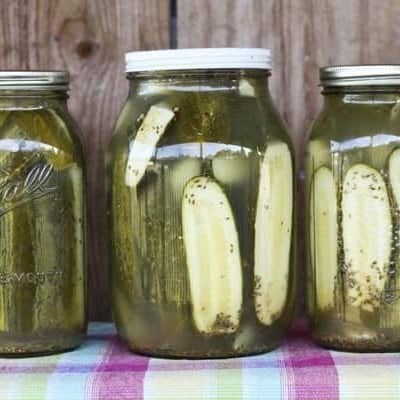
Homemade Claussen Knock-Off Pickles
Equipment
- 1 gallon jar or 4 quart jars or a large, food-safe container with a tight fitting lid
- 1 liquid measuring cup
- 1 large mixing bowl or pitcher
Ingredients
- 35 to 40 small to medium pickling cucumbers
- 1 gallon cold water
- 1 cup apple cider vinegar, preferably raw or white distilled vinegar
- 2/3 cup coarse canning or kosher salt Do NOT fine or use iodized salt!
- 4 cloves garlic or more to taste
- 4 heads fresh dill or 4 tablespoons dried dill seed not weed!
- 2 tablespoons mixed pickling spices
Instructions
- Wash cucumbers but do not scrub them.
- Trim 1/8-inch from the blossom end of each cucumber and slice in half lengthwise or into quarters, depending on how large your cucumbers are and how big you want them to be when they’re done.
- In a gallon jar (or large, wide-mouth, food-safe container) layer the dill heads or seed, garlic cloves, pickling spices and sliced cucumbers.
- In a separate pitcher or bowl, stir together the remaining ingredients until the salt is dissolved.
- Pour the brine over the cucumbers, taking care to make sure all of them are fully submerged. If needed, place a plate or mug or other non-reactive heavy item on the cucumbers to weigh them down and keep them under the brine!
- Cover lightly with a lid just perched on top or secure a piece of cheesecloth over the jar with a rubber band to keep fruit flies away.
- Leave out of direct sunlight on the counter for two to four days*, or until the cucumbers taste like pickles throughout.
- Fix your lid onto your jar or container and chill. These can be stored in the refrigerator for up to six months provided you keep them covered with brine.
- *If at any point in the proceedings “fuzz” or “foam” develops on top of the brine, use a spoon to remove it. If there is “fuzz” attached to any of the cucumbers, remove the ones affected and be sure the others are still fully submerged.
Notes
Nutrition
Nutritional information is an estimate and provided to you as a courtesy. You should calculate the nutritional information with the actual ingredients used in your recipe using your preferred nutrition calculator.
did you make this recipe?
Make sure to tag @foodiewithfam on Instagram and #hashtag it #foodiewithfamily so I can check it out!
Originally published July 22, 2011. Updated with FAQs and Troubleshooting and reposted August 2022.
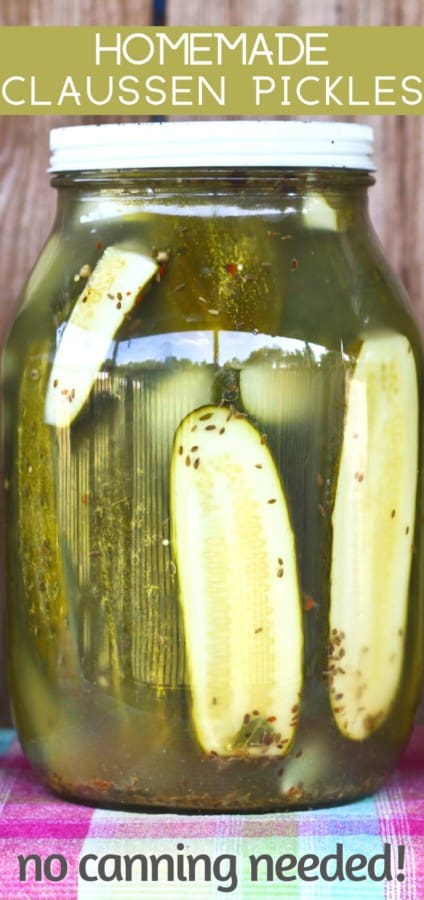
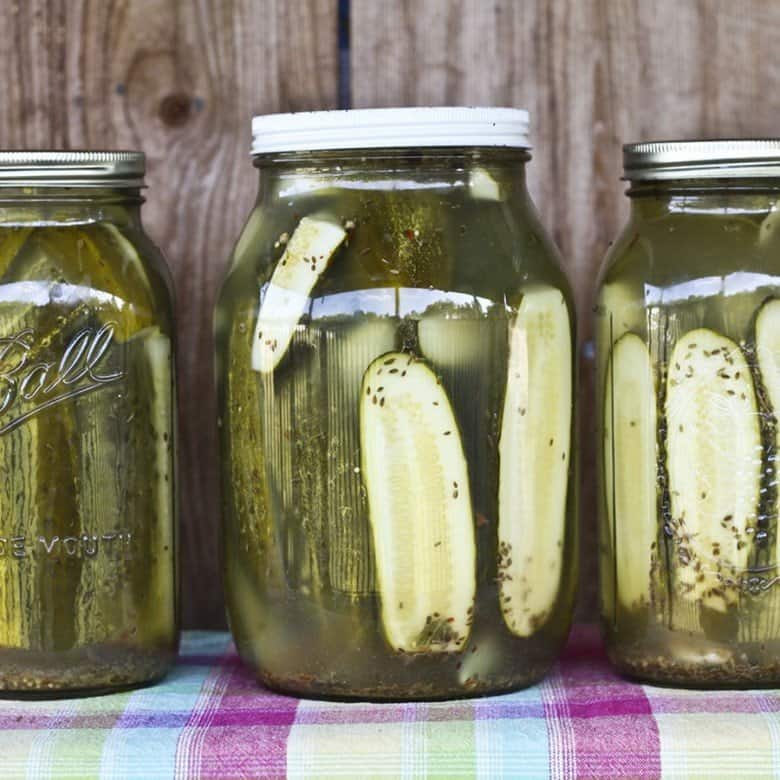
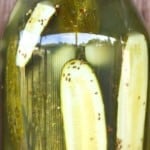



Reader's Thoughts...
Marlo says
Can you slice them into slices you’d use for like a burger or do they have to be spears?
So excited to try this!!!
Tom says
Thanks for getting back to me so quickly. Taken in that context your recipe is very similar to the one I have used for years: Two quarts of water, 6 Tbs salt, 3 Tbs vinegar. This makes the exact amount of brine needed for a gallon of cukes. I let them ferment for about two weeks before refrigerating. We’re definately on the same page.
Tom says
I must be missing something. If I fill a gallon jar with cucumbers, how is a gallon of water, plus a cup of vinegar, plus 2/3 cup of salt going to fit in the jar?
Rebecca says
Hi Tom, Good question. The answer is that it won’t. On the plus side, the brine stores well in the refrigerator for a later batch of pickles (assuming you make another.) 🙂
scott manion says
Rebecca, In the interest of canning these pickles for long time storage without loseing the crunch,, do you suppose that “pickle crisp” could be used without fouling the recipe??I was thinking about adding it After fermentation was complete, just before the hot water bath to seal the lid??? Your thoughts???
Rebecca says
Hi Scott. To me, the appeal of this particular pickle is the fact that it isn’t processed. I really haven’t tried heat-sealing them. When I do heat sealed pickles, it’s the other recipe I have up here on the site. I’d love to know how it goes if you try them, though!
chris says
You say use 1 gallon of water, do you mix the gallon of water with the 2/3 cup of salt and vinager and then use what brine it takes to fill up the gallon jar that has the pickles already in it.
Rebecca says
Yes you do! You got it!
Mike says
Just brought home a nice load of picklers from the local farmer’s market yesterday, got my jars washed, and about to start mixing up the brine to try some of these. They look and sound wonderful!
Kelly says
Why the need for vinegar? Fermented pickles taste vinegary with OUT vinegar added…
Rebecca says
Mainly because that’s how I learned to make them and I like them that way!
heather says
Every year I try my hand a making pickles and every year I get that cloudy area at the bottom of the jar and I toss them out because I don’t know how to tell if they are still good or if I am growing some bacteria that will land my family in the hospital.
What is that cloudy area? Is it safe? Can I make pickles without it?
Rebecca says
Heather, my research shows that the cloudy area in fermented pickles (such as these) indicate the presence of lactic acid (a by-product of fermentation.) That is backed up by several cooperative extension groups’ literature (like this: http://www.clemson.edu/extension/hgic/food/food_safety/preservation/hgic3101.html ) However, and this is a big one, you need to be the one who makes that decision. Mine are almost always cloudy, but I’m serving a family that has hearty immune systems and is not prone to getting ill. If my family had any immune-compromisation going on, I would be infinitely more cautious. It has to be your call!
Janet says
I am trying your receipe today, I can’t wait! Fresh kirby cucumbers from my garden. Can I save the leftover brine? I only have enough cucs for 2 quarts. I put some in a canning jar, but I’m not sure if I should leave it out or refridgerate? thanks
Rebecca says
I would say you’re absolutely fine if you refrigerate it!
Sharon says
Is there any way to process these pickles for long term storage. I would like to make a large batch, but do not have the room in my refrigerator to keep them all. Any information would be deeply appreciated.
Rebecca says
I’m sorry to say, but if you heat process them you’ll lose all that fabulous crunch. 🙁
Anna Eastman says
I made these and loved them. I used pint and a half jars. Sliced them long ways into quarters. I packed them pretty tight. I made the brine. I used distilled water, Bragg’s apple cider vinegar. I put several whole pepper corns and dill seed in each jar. I also used my garlic press and pressed a couple garlic cloves in each jar. I tasted them after a couple of days and they didn’t seem salty enough. I ended up putting about a half teaspoon of coarse salt into each jar. I made a larger jar and they didn’t turn out as well. These are a great pickle! Thanks for your recipe.
Rebecca says
I’m so glad you like them, Anna!
Alyson says
Hi Rebecca,
I accidentally let my pickles sit out/ferment on the counter for 6 days. For some reason I thought they were supposed to sit out for that length of time. I tasted one this morning and it seemed to be fine. Other than the brine looking murky I never saw any fuzz. I went ahead and put them straight into the fridge with the lid on. Do you think they are OK after sitting out for a week?
Rebecca says
Hi Alyson… I think you’re fine! You just took it a step further and made full sours instead of half sours (think deli lingo.) Of course, use your own judgment based on smell, taste, appearance, etc… but if they are as you say they are, they should be safe.
D. Morin says
I concur with everyone above..these pickles look awesome. Can these be made without the salt? is it part of the pickling process or just for taste? I’m on a 1/4 of sodium per day ration.
D. Morin says
that should be 1/4 tsp per day ration.
Rebecca says
Hey there! I’ll be honest with you. I’d be a little wary of eliminating the salt. It is both a preservative and a flavouring agent. I understand, though. I’m a pickle maniac. I’d hate to go without. I found this link for homemade low-salt pickles (disclaimer: I haven’t tested it, but it’s on a site I have had success with in the past!) http://www.pickyourown.org/lowsaltpickles.php
Barbara says
You can’t use it for canning because of the anti-caking agents but MORTON’S LITE SALT, half salt – half potassium salt substitute will allow you to a half teaspoon instead of a quarter teaspoon for seasoning your meals. I’ve used it since it was released and prefer it’s flavor.
Allison says
This is the exact type of recipe I’ve been looking for! But can I process it for a longer shelf life? I know Claussen’s need to stay refrigerated, but I don’t think I have enough room in my fridge for so many pickles. Also, my friend’s always want pickles as gifts! So, processing- yay or nay?
Rebecca says
Allison- I am so sorry to tell you this, but you might need to buy a pickle fridge. 🙂 Unfortunately, these do not process well. They’re meant to be a fresh/fermented pickle.
large dave says
this is quite late. but they will be shelf stable if the PH is under 4.6. So once you are done “pickling” you can add extra vinegar to bring the PH down. Make sure to agitate & mix the brine with the vinegar quite well before taking measures. Also it’s vital that the pickles stay under the brine & don’t float up. As long as you follow the 4.6 or lower PH rule, they will be safe
Alexi Murphy says
Ruby,
Do you know if this recipe will work with something like green beans? The cucumbers we did with this turned out excellent and now I’m wondering about pickled green beans
Kat says
These look awesome. Just one question though. Should regular apple cider vinegar be used or the raw kind like, Bragg’s?
Pat says
Oh, wow…I can hardly wait until summer to try this recipe!! I’ve made pickles for years using the boiled vinegar method. Sometimes, they turn out good and crunchy and sometimes for no reason, they are mushy with an off taste. My only thing is…if they only last 6 months in the fridge, what will we do for the rest of the winter till we can make more???!!! :o)
Chelsea says
I love this recipe, it’s the only one I’ve found that dosent have sugar in it and I love claussen’s pickles… but, how would you recomomend going about re-sizing the batch for a smaller amount, such as 1-2 pint jars of pickles?
Shelly says
Does the brand of pickling spice matter? I’m not a snob about much of anything…but I’ve always only liked Claussen Kosher Dills. (I’m a pickle juice drinker, too, and as a kid, my favorite sandwich was peanut butter and pickles! ha! ) But I don’t even like other dill pickles. All that to say, if your pickles taste just like Claussen’s, I want to be sure to get it right. My husband is thick in garden-planning mode right now, and I know if I don’t have my recipe ready, we’ll be up nights this summer canning pickles I won’t eat :(. Tragedy, indeed. 😉 So, could you divulge your brand of pickling spice, please???
Rebecca says
Well, Shelly… I honestly don’t know the brand I use. I buy the bulk packages up at my local Amish grocery. One thing, though, is that I pick all the cloves and cinnamon bark out of the pickling spice. I don’t like those flavours in my pickles. I’d say that as long as your pickling spice is pretty standard (McCormick’s, Spice Islands, Frontier, etc…) you’ll be fine!
Emily says
I am glad I read this comment. I should have read the whole comment thread before making the recipe. I would say this up higher in the actual recipe. I just pulled a pickle out to taste it, and the clove taste jumped out strong, more than a claussen taste. The pickle was good, but not the flavor I expected. I wish I had known that you pulled those out. I’ll do it for the next batch. Thank you!
Rebecca says
I’m glad you read it, too! I am not a fan of cloves in savoury pickles, but I always figure I’m a loner since most pickling blends include it!
Andrea (questfordelish) says
these looks great. I love clausen pickles. I always affraid they are too hard to make them myself. Maybe I will give these a try.
Augusta Wise says
Jessamine. Do not screw a lid into place! They come out really good, even cooked!
Lisa says
I just made my first ever batch of pickles yesterday thanks to how easy you made this! Great photos by the way…
The smell of the brine is already out of this world. Can’t wait to try them!
On a side note, I stuffed the jar so tightly that I don’t have to worry about any not being covered by the brine. There is plenty of room between the sliced cukes, but they won’t float, which is great and I don’t have to worry about any touching the air.